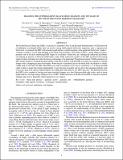IMAGING THE SUPERMASSIVE BLACK HOLE SHADOW AND JET BASE OF M87 WITH THE EVENT HORIZON TELESCOPE
Author(s)
Lu, Rusen; Broderick, Avery E.; Baron, Fabien; Monnier, John D.; Fish, Vincent L.; Doeleman, Sheperd Samuel; Pankratius, Victor; ... Show more Show less
DownloadLu-2014-IMAGING THE SUPERMAS.pdf (1.614Mb)
PUBLISHER_POLICY
Publisher Policy
Article is made available in accordance with the publisher's policy and may be subject to US copyright law. Please refer to the publisher's site for terms of use.
Terms of use
Metadata
Show full item recordAbstract
The Event Horizon Telescope (EHT) is a project to assemble a Very Long Baseline Interferometry (VLBI) network of millimeter wavelength dishes that can resolve strong field general relativistic signatures near a supermassive black hole. As planned, the EHT will include enough dishes to enable imaging of the predicted black hole "shadow," a feature caused by severe light bending at the black hole boundary. The center of M87, a giant elliptical galaxy, presents one of the most interesting EHT targets as it exhibits a relativistic jet, offering the additional possibility of studying jet genesis on Schwarzschild radius scales. Fully relativistic models of the M87 jet that fit all existing observational constraints now allow horizon-scale images to be generated. We perform realistic VLBI simulations of M87 model images to examine the detectability of the black shadow with the EHT, focusing on a sequence of model images with a changing jet mass load radius. When the jet is launched close to the black hole, the shadow is clearly visible both at 230 and 345 GHz. The EHT array with a resolution of 20-30 μas resolution (~2-4 Schwarzschild radii) is able to image this feature independent of any theoretical models and we show that imaging methods used to process data from optical interferometers are applicable and effective for EHT data sets. We demonstrate that the EHT is also capable of tracing real-time structural changes on a few Schwarzschild radii scales, such as those implicated by very high-energy flaring activity of M87. While inclusion of ALMA in the EHT is critical for shadow imaging, the array is generally robust against loss of a station.
Date issued
2014-06Department
Haystack ObservatoryJournal
Astrophysical Journal
Publisher
Institute of Physics/American Astronomical Society
Citation
Lu, Ru-Sen, Avery E. Broderick, Fabien Baron, John D. Monnier, Vincent L. Fish, Sheperd S. Doeleman, and Victor Pankratius. “IMAGING THE SUPERMASSIVE BLACK HOLE SHADOW AND JET BASE OF M87 WITH THE EVENT HORIZON TELESCOPE.” The Astrophysical Journal 788, no. 2 (May 29, 2014): 120. © 2014 The American Astronomical Society.
Version: Final published version
ISSN
0004-637X
1538-4357